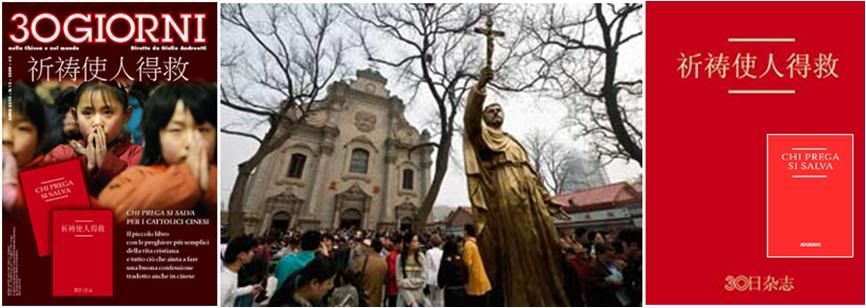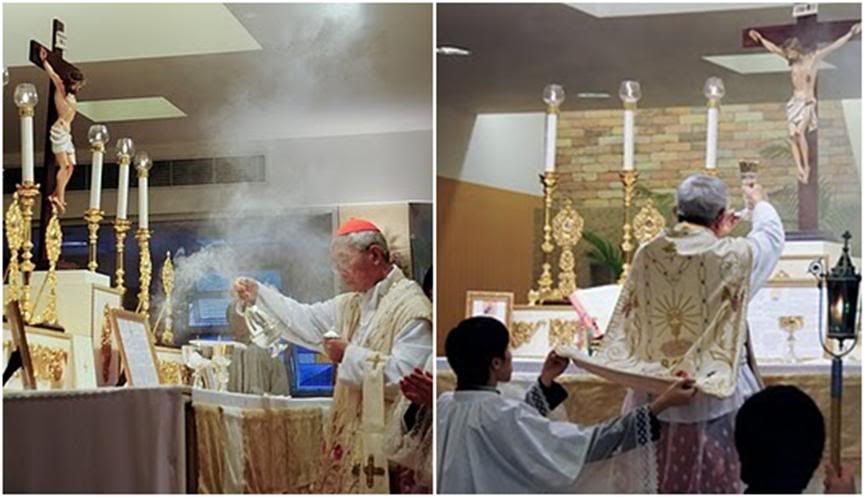 The difficulty of
The difficulty of
reconciliation in China
by ANDREA TORNIELLI
Translated from

January 29, 2010
 Center, parishioners after Sunday Mass in Beijing's cathedral. Right photo, a Chinese edition of a 30 GIORNI book of prayers [He who prays, saves himself], originally published in Italian with an introduction by Cardinal Joseph Ratzinger, and which has now been translated to Chinese.
Center, parishioners after Sunday Mass in Beijing's cathedral. Right photo, a Chinese edition of a 30 GIORNI book of prayers [He who prays, saves himself], originally published in Italian with an introduction by Cardinal Joseph Ratzinger, and which has now been translated to Chinese.
The December 2009 issue of the magazine 30 GIORNI which comes out today carries a dossier that should be of interest to understand something of the situation in the Church in China two and a half years since Benedict XVI's unprecedented pastoral letter to the Catholics of China.
The dossier, edited by Gianni Valente, includes some documents that have not been published before which contribute to clarify many errors that have characterized reporting on the issue by the news agencies, as well as many Web sites, which tend to present a negative view of the work of the Vatican Secretariat of State, and more generally, the Holy See itself, and claim that for reasons of Realpolitik, the Vatican is abandoning the so-called 'underground Church' in China to its own fate.
As a necessary premise, it must be remembered that
1. There is only one church in China, not two.
2. Almost all the 'official' bishops recognized by the Beijing government are also recognized by the Vatican.
3. Both Catholic communities - 'underground' and 'official' - have been the object of persecution over the past six decades.
4. In his 2007 letter, Benedict XVI suggested a precise way towards reconciliation and overcoming the division between the two communities.
An emblematic case, presented by the magazine, is Bishop Francis An Shuxin, who was detained for 10 years by the Communists, and is now facing opposition by some of his own brothers in the faith.
Earlier auxiliary bishop and now coadjutor of Baoding, a city some 150 kms from Beijing, An was detained in isolation from 1996 to 2006, and after his release, decided to go 'above ground' in order to exercise his mandate, following procedures imposed by civilian authorities.
Today, some priests and faithful in the underground Church accuse him of betrayal and do not recognize his authority.
In documents published by the magazine, An explains his reasons for emerging from clandestinity, agreeing to register himself with the civilian authorities, but without any compromise in his faith (for instance, not signing a provision regarding election of bishops without Vatican approval, and adding an eloquent explanatory note "on the ground of not violating Catholic faith", to the provision referring to the principles of self-management and autonomy of the Church in China).
30 GIORNI also discloses that the Holy See, in 2006, had sent the diocese various documents recognizing An's legitimate authority as a bishop as soon as he became 'official' - but the documents have been ignored by underground priests opposed to An's decision.
The legitimacy of An's ministry was reiterated in a June 2008 letter from Cardinal Ivan Dias, Prefect of the Congregation for the Evangelization of Peoples, with appropriate references to Benedict XVI's June 2007 letter: "Everyone should know that the esteemed bishop (An) enjoys the approval and total confidence of the Holy See. Therefore, no one should doubt his sincerity nor oppose his authority".
Bishop An, says the dossier, testified that "After the publication of the Holy Father's Letter in 2007, many priests
[among them, those who oppose An] kept the faithful from reading the pastoral letter, saying that the Pope was confused".
Therefore, it was not by chance that last November, Cardinal Tarcisio Bertone wrote a letter to all Chinese priests on the occasion of the year for Priests, reiterating
the Holy Father's urging for reconciliation within the Catholic community, along with respectful and constructive dialog with civilian authorities, following the 'guidelines' in the Pope's letter.
So, the reality of the Chinese situation is far more complex than it is usually presented in Western reporting, and distortions and resistances can be found even in the 'underground' community which seems, on the whole, to be interpreting the Pope's letter as they see fit.
I have done a cursory reading of the articles in the 30 GIORNI dossier, a journalistic enterprise which, I understand, was made possible when magazine editor and publisher Giulio Andreotti travelled to Tibet last fall to take part in an international symposium on the Tibet question.
What struck me was the failure on the part of 30 GIORNI to get some direct input from Cardinal Joseph Zen, who is an advocate of the underground Church and often speaks up for them - and which 30 GIORNI writer Gianni Valente points out - but was also entrusted by the Holy Father to 'monitor' the consequences of the papal letter on the two Catholic communities in China.
Speaking of Cardinal Zen, Carlos Antonio Palad at

calls attention to the last traditional Latin Mass offered by the Cardinal in Hongkong on December 29:


The cardinal offered a Solemn Pontifical Mass in the Extraordinary Form last Easter. Palad also informs us that the Cardinal "has actually volunteered to be part of the line up of priests who alternate in celebrating Hong Kong's Sunday TLM. To my knowledge, he is the only cardinal who frequently celebrates the TLM in a fixed site".
THE PRAYER BOOK
Cardinal Joseph Ratzinger wrote the Introduction for the prayer book
published by 30 GIORNI in 2005 just three months before he was elected Pope.

Here is a translation of the Introduction:
Since man was man, he has prayed. Always and everywhere, man has realized that he is not alone in the world, that there is someone who listens. He has always realized that he needs Another much greater than he, to whom he should address himself so that his life may be what it ought to be.
But the face of God had always been hidden, and only Jesus has shown us his true face, Whoever sees Him sees the Father (cfr Jn 14,9). Therefore, if on the one hand, praying comes naturally to man (to ask in times of need and to thank in times of joy), on the other hand, there is also man’s inability to pray and to speak with a hidden God. We do not know what we should ask, St. Paul writes (cfr Rm 8,26).
And so, we should always ask the Lord, as the disciples did: “Lord, teach us to pray!” (Lk 11,1). The Lord has taught us the ‘Our Father’ as a model for authentic prayer, and has given us a Mother, the Church, who helps us to pray.
The Church has received from Sacred Scripture a great treasury of prayers. In the course of centuries, there have also emerged, from the hearts of the faithful, numerous prayers with which, ever anew, they address themselves to God. In praying with Mother Church, we ourselves learn to pray.
I am therefore very happy that 30 GIORNI is publishing a new edition of this little book containing the fundamental prayers of Christians, as these have taken form through the centuries. May they be with us in all the events of our life and help us to celebrate the liturgy of the Church in prayer.
I hope that this little book can be a traveler’s companion to many Christians.
Rome, February 18, 2005
JOSEPH CARDINAL RATZINGER
[Modificato da TERESA BENEDETTA 30/01/2010 18:34]